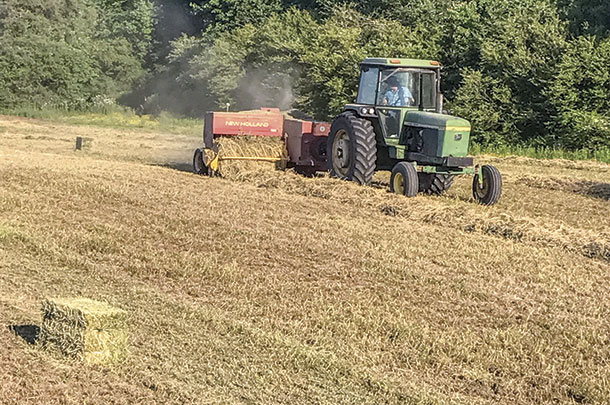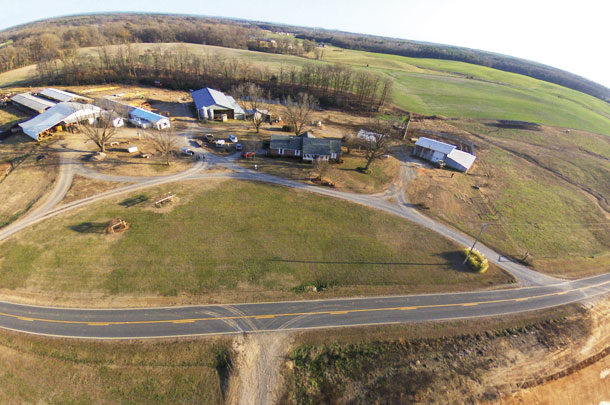Present-day Brent Stegall Farms got its start in the early 1900s as a small dairy farm. Marion Lafayette Stegall and his son Floyd merely sought to support their family, never knowing or dreaming how much their farm would grow.
Over the years, their small dairy operation flourished into a state-of-the-art milking parlor. Cecil Stegall, Floyd’s son, continued the tradition. In the late ’70s, Cecil started to dabble in growing alfalfa on the family homestead. A generous neighbor up the road gave him 5 acres to start and, ever since, alfalfa has been grown on the farm as a food source for the cows and as a source of revenue with the general public.
In 2006, Cecil sold his operation to his son Brent, now the fourth-generation Stegall to own and operate the farm. At this time, Brent’s son Chris and grandson Michael returned to the family farm and showed a tremendous interest in alfalfa. The fall of 2016 marked the first season Brent Stegall Farms became a commercial alfalfa and grass hay dealer.

Today, Brent Stegall Farms has prospered into a 690-acre enterprise, growing 215 acres of alfalfa, 100 acres of ryegrass double-cropped with crabgrass in the summer, as well as grass hay, corn, wheat and soybeans. The farm that has been passed down father to son is finally reaching its true potential, and alfalfa is leading the way.
Many people are surprised to find alfalfa in North Carolina. However, Brent and Chris report alfalfa, along with ryegrass, crabgrass, silage corn and silage soybeans, can all tolerate the somewhat unpredictable weather conditions of North Carolina, despite popular opinion.
“We are trying to prove alfalfa can be grown in the Southeast,” Brent says. “We want to be the ones to prove we can grow high-quality alfalfa here.”
As with many farming operations, the biggest detriment to business is the ever-temperamental weather. The humid Southeast is not kind to hays, particularly when drying to bale. Brent’s operation, along with many others like it, does not have irrigation, so precipitation is vital. Some years, they get three cuttings, and other years it might be six. Adaptation is key to success.
Although Brent Stegall Farms has only been a commercial alfalfa grower for two years, they’ve already expanded their alfalfa acreage to 215 acres and have a goal to expand to 500 acres in the next five years. They’ve found, more often than not, the reward is far greater than the risk.

Similarly, the cost of maintaining and harvesting the crop is a huge challenge. With all the input costs rising (such as is the case with fertilizer, fuel, equipment cost, parts and other necessities), it’s challenging to maintain cash flow year to year. Beyond that, many growers regard alfalfa as a risky endeavor in a temperamental climate such as the Southeast.
As all farmers know, it only takes one bad year to put you deep in the hole. Yet Brent and Chris have a simple response to this: “Alfalfa is a different ball game. People who attempt to grow or think about growing it don’t realize how much cost and labor is involved in raising the crop year after year,” Chris says. “Every growing cycle is 28 to 30 days, no matter what you are doing.
The next three to five days are dedicated to getting it cut, raked, baled and stacked in the barn. It is hard to grow unless you know what to do. But it is not impossible. You just have to have patience and willingness to learn.”
Once you have your crop, the results are wonderful. Brent and Chris usually bale alfalfa into small square bales which are sold into the horse, sheep and goat industries in both North and South Carolina. When the weather doesn’t cooperate with them, they put up haylage for their dairy operation and others nearby.
The primary end consumers of alfalfa in the Southeast are horses and goats, especially dairy goats. Brent and Chris are continuing to expand upon that existing market and have found success with their product. In addition, Brent Stegall Farms sells to a few sheep producers, and they are beginning to market to small cow dairies that produce high-value products.
Though alfalfa is not a leading agricultural product in the Southeast, and many don’t look for it there, Brent and Chris have perfected two wonderful marketing strategies, the first being word-of-mouth. They pride themselves on a good-quality end product, and personal recommendations are perhaps their most effective strategy. “When dairymen brag on how well their animals are performing on your hay, others get curious and want to try it for themselves,” Chris reported.
Secondly, Brent and Chris have created a Facebook page (Stegall Farms LLC). Chris and Brent have already had people, both farmers and consumers, asking questions on certain agronomic scenarios since alfalfa is not commonly grown in the Southeast – and they are delighted people are taking notice of their operation and the industry. Social media has helped them get the word out that alfalfa is not only growing in North Carolina, but is booming. A website is also in the works.
At the end of the day, the customers are what make it worthwhile for Brent and Chris. Meeting customers, learning their backgrounds and hearing about how they are going to incorporate hay into their nutrition plan gives the sometimes difficult days an uplifting edge.
“What makes me feel really good about what I do is when [customers] brag on the hay and how it has turned their animals in how they look and act,” Chris says. “It makes you feel like you are doing something right, even though this is a tough industry to be in.”
Through all of the ups and downs, Brent Stegall Farms has remained a family living its dreams and making the impossible happen. Brent and Chris have taken a simple family farm and cultivated it into a thriving operation. The Stegalls’ legacy is a huge influence in their success, with six generations of hard-working farmers calling the land their own. They take pride in what they do, and they are proving to the world alfalfa is possible in the Southeast. ![]()
PHOTO 1: A bird’s-eye view of Brent Stegall Farms in Peachland, North Carolina.
PHOTO 2: A 30-acre field of alfalfa during mowing at Brent Stegall Farms.
PHOTO 3: Brent Stegall bales hay. Photos courtesy of Brent Stegall Farms.
Maddy Quast is a student at BYU – Idaho, currently studying communication and public relations.










